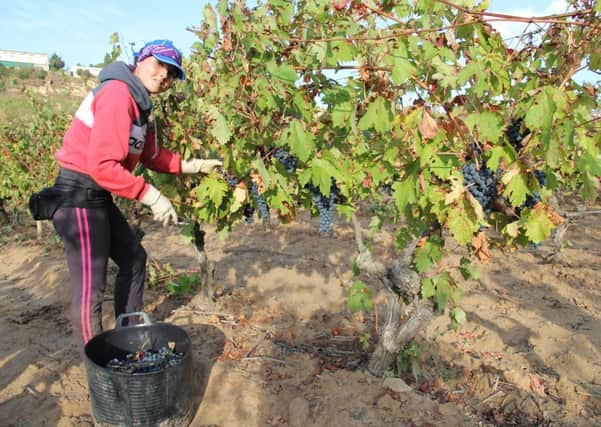Wine: Rocking Rioja


It was easy to see the damage the storm had wreaked. The grapes were still there, their outer berries bearing battle scars while the rest of the bunch remained vulnerable to mould. These vines would be picked but the crop was destined to be thrown on the ground, unfit for purpose. “We have lost around 85 per cent of our crop, but amazingly some parts of the vineyard were not touched so this will be a quick and very small harvest.” Indeed, just 50 metres away the harvesters were out, hand-picking healthy, ripe, blue-tinged Tempranillo grapes for Contino wines, but as the crop enters the winery all the grapes will be checked, berry by berry to make sure they are perfect.
Of all the wine regions in Spain, Rioja is the one everybody knows. It stands out on the shelves as a beacon for reliable, warm flavours and utmost quaffability. One of the joys of Rioja is the easy-to-follow quality grading, with young wines occupying the lower end of the price range rising to Crianza, Reserva and Gran Reserva, each one a distinct step up from the previous grade, reflecting its increasing age. There’s dozens of brands too, plus own-label versions from supermarkets, covering every price point.
Advertisement
Hide AdAdvertisement
Hide AdBecause of this well-established structure, the market for Rioja wines in the UK has risen steadily and it has become the success story of Spain. But instead of resting on their laurels and enjoying this period of prosperity, many Rioja producers are going back into their vineyards to create new styles and fresher flavours for their markets. It has resulted in a modern face of Rioja now standing side by side with the old.
Rioja is in northeast Spain, in an area of rolling hills, backed by a range of mountains known as the Sierra de Cantabria that provide shelter from cold winds from the Bay of Biscay. The climate is bitterly cold in winter and warm in summer, with long autumns to ripen the grapes. The soil varies across the region, from chalk-rich clay to sandy, alluvial soils, dividing naturally into three parts; Rioja Alavesa, north of the River Ebro which produces fresh-tasting young wines; Rioja Alta on higher ground south of the river producing elegant, full-flavoured wines while the hotter Rioja Baja produces spicy, peppery wines. These three areas provide the building blocks of flavour that winemakers use to shape their wines.
Grape varieties for red Rioja include Spain’s classic variety, Tempranillo that provides supple fruit and good acidity. Also planted is Mazuelo for weight and tannin, Garnacha for warmth, spice and ripeness plus Graciano, a variety that is gradually making a comeback for the finesse and longevity it gives to a wine. Maturana is a new addition to this list although it has been planted in the region for centuries. Possibly related to Trousseau in Jura and Bastardo in Portugal, Maturana has been rescued from the brink of extinction and re-planted in new sites to rediscover its character. According to Jorge Muga, winemaker at the famous Muga company, who has planted 10 hectares of Maturana at 600 metres altitude, it adds richness to the blend and will definitely once again have a part to play in Rioja.
I spent five days in the region, visiting most of the major names and many of the smaller ones too, and across the region, despite the storm and the small harvest there was a dynamic atmosphere with new investment and pioneering work in vineyards.
Advertisement
Hide AdAdvertisement
Hide AdLeading the research is Juan Carlos Sancha, professor at Logroño University and guardian of a vineyard containing many old varieties.
“In 1912 there were 44 grape varieties used in Rioja and now there are just a handful. Tempranillo was just a minor variety then.” By talking to old farmers he found 27 previously unknown grape varieties across the region and he has propagated and planted them, making wine in small batches to find out their characters. In the end he selected six previously ‘lost’ varieties and built up enough plant material for them to be sent out to producers.
Tempranillo Blanco, Maturana Blanca, Turruntés (no relation to Torrontés), Monastel (apparently quite different from Monastrell) and two versions of red Maturana will probably never be as dominant as Tempranillo and Garnacha, but they show that the region has an open mind and a developing style.
Other developments are in the wineries. While old-style Rioja producers boast about how many years their wines have spent in oak there are many wineries moving way from the standard 225 litre American oak casks to more restrained, elegant French oak. Gleaming modern wineries such as Ysios make a dramatic, architectural statement in a historic landscape while other long-established wineries are gradually changing their methods while keeping a considered eye on the history and the continuing success of the region.
Advertisement
Hide AdAdvertisement
Hide AdNext week I will review some of my favourite Rioja producers but in the meanwhile, to get your tastebuds in tune with the wines of this dramatically beautiful region here are some recommended supermarket Riojas for under a tenner.
The Wine Selection Marqués del Norte Rioja 2012, Asda, £5: Easy jammy fruit, with bright cherry and raspberry flavours.
Perez Burton Rioja 2011, Marks & Spencer, £9.99: Telmo Rodriguez, one of the new generation of winemakers uses specially selected bush vines. Definitely worth its price tag.
Winemaker’s Selection Rioja Reciente NV, Sainsbury, £5.49: Terrific value in this lively, juicy wine. It has been aged in oak, but not long enough to hide the fruit.
Advertisement
Hide AdAdvertisement
Hide AdTesco Finest Viña Mara Rioja Reserva 2008, £9.99: From Baron de Ley, one of the important names of Rioja, this has lush, deep, red berry fruit with gentle, integrated oak. A good wine to pair with lamb.